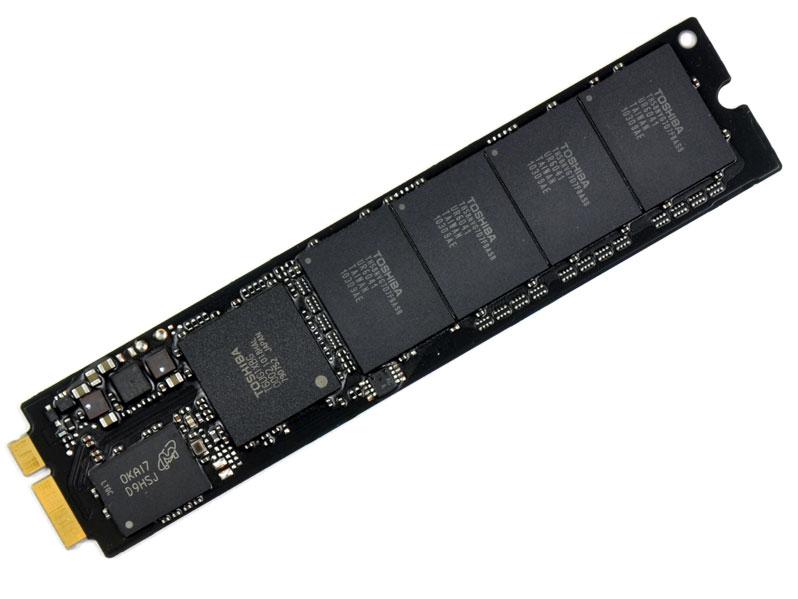This week, Apple was both reported to be close to acquiring flash memory chip designer Anobit and engaging in plans to set up a semiconductor development center in Israel, where Anobit is located.
Apple already uses Anobit components in is iOS devices and the MacBook Air. The firm's unique flash memory technology, dubbed MSP or "Memory Signal Processing," is designed to enhance the reliability, performance, efficiency and endurance of flash memory.
The pros and cons of flash memory
Unlike DRAM, which stores memory bits using the state of electrical capacitors which must be continuously refreshed with power, NAND flash memory stores bits using floating gate transistors, which do not need to be continually refreshed to maintain their state.
This makes flash memory more energy efficient during operation, and allows it to retain its information even after the device is shut down. The use of flash memory storage in iOS devices and the MacBook Air provides long term storage of software, documents, music and movies without needing a conventional magnetic hard drive for disk storage.
The use of flash storage not only makes these devices quick to boot up and launch apps, but also slimmer, more battery efficient and less fragile than compatible devices using a conventional hard drive for persistent storage. Particularly on iOS devices, the use of fast flash memory also limits the need for large amounts of DRAM, further increasing the devices' battery life.
On the flip side however, flash memory storage is more expensive compared to disk storage, as well as being less reliable and having a shorter life span. The individual cells of flash memory chips eventually wear out and stop working reliably, requiring specialized software to manage their use.
Strengthening flash memory
Earlier this year, Apple incorporated TRIM support in Mac OS X Lion. TRIM is an OS level software technology designed to manage the flakey, short lived nature of flash memory used in Solid State Drives like the MacBook Air's (pictured below).
Anobit's MSP technology attacks the same issues, but does so on firmware level, using sophisticated monitoring of flash memory cells to accurately determine if they are failing or no longer able to reliably store data. These technologies also enable flash memory to continue to function longer than previously possible by simply working around failures.
In addition to enabling flash memory to live longer, MSP also promises to make components faster; it enables data to be pushed to flash memory at speeds that generate more errors, but can then detect and correct the errors.
Cheaper SSDs and flash memory
A second primary benefit to the MSP technology is that it makes less expensive types of flash memory usable for a wider range of applications. Most flash memory used in high speed storage holds one bit per memory cell, known as SLC or "single level cell" memory.
A cheaper type of flash memory known as MLC or "multi level cell" can store two bits per memory cell, making it less expensive to manufacture because it has a higher memory density. A primary problem with MLC is that is more prone to error, requiring more sophisticated management to make it useful.
MSP promises to make cheaper MLC memory components as accurate over the same lifespan as conventional SLC, something that would dramatically change how much storage Apple could pack into its devices and computers at the same price. That would have a huge impact on Apple's ability to compete, as flash memory storage is a significant part of the bill of materials in the devices it builds.
NAND flash is the second most expensive component of the iPad (after the touchscreen display), according to iSuppli, accounting for around ten percent of its total component cost. For the MacBook Air, 64GB of SSD flash memory is similarly estimated to be its second most expensive component (again, after the screen) and roughly the same price as its Intel CPU at a similar 10 percent of the total materials cost.
 Daniel Eran Dilger
Daniel Eran Dilger








-m.jpg)






 Brian Patterson
Brian Patterson
 Charles Martin
Charles Martin


 Malcolm Owen
Malcolm Owen
 William Gallagher
William Gallagher
 Christine McKee
Christine McKee
 Marko Zivkovic
Marko Zivkovic







42 Comments
Apple is diversifying its capability geographically and technologically, a smart move.
Thanks Dan.
I was wondering what this deal was about. Good explanation and good to know.
There is no such thing as Flash RAM, Appleinsider needs to strive for at least a bit of technical accuracy!
RAM = Random Access Memory
The flash memory used in Apples devices is NOT random access. That is a significant error that is seen far to often on the net. Beyond that Flash is used as secondary storage in these machines. Real RAM is primary storage, directly addressable by the processor and is seldom used for secondary storage. Access to flash has more in common with accessing a disk drive than it does RAM.
There is no such thing as Flash RAM, Appleinsider needs to strive for at least a bit of technical accuracy!
RAM = Random Access Memory
The flash memory used in Apples devices is NOT random access. That is a significant error that is seen far to often on the net. Beyond that Flash is used as secondary storage in these machines. Real RAM is primary storage, directly addressable by the processor and is seldom used for secondary storage. Access to flash has more in common with accessing a disk drive than it does RAM.
Yet I remember using RAM to create .... RAM disks. Virtual disks that acted like hard drives but were in fact in RAM. So isn't this all a bit esoteric?
There is no such thing as Flash RAM, Appleinsider needs to strive for at least a bit of technical accuracy!...
I've designed with Flash and completely overlooked the language that Dan used. \
However, perhaps unified memory isn't too far away - http://cacm.acm.org/news/104104-ncsu...evice/fulltext